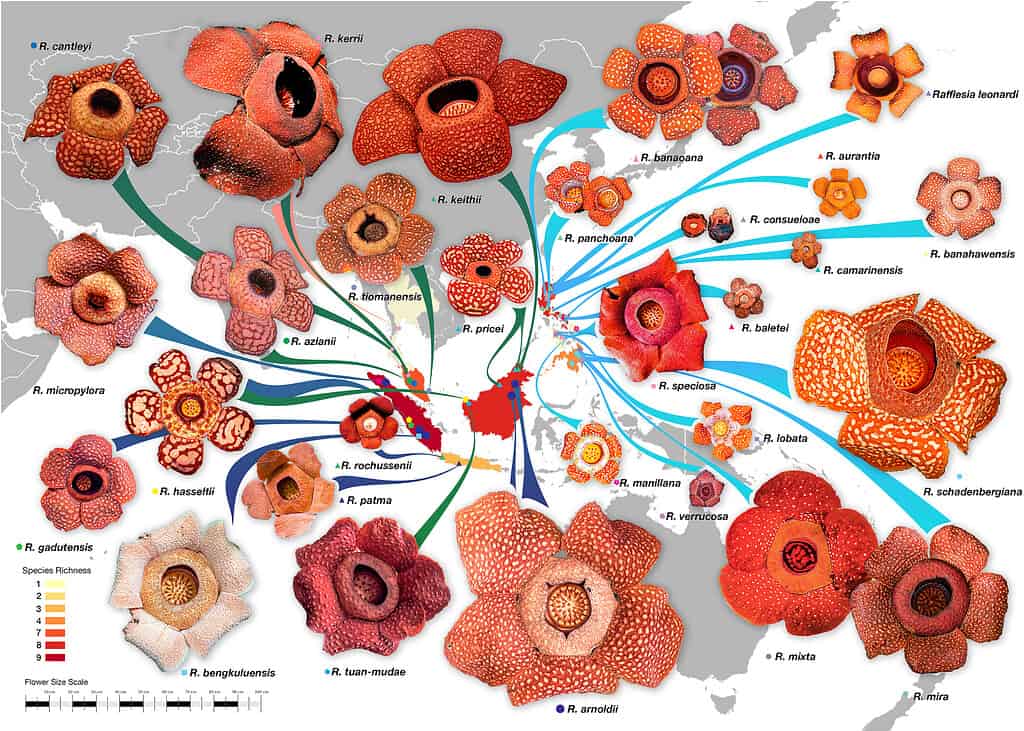An international group of scientists are urgently calling for coordinated action to save the genus Rafflesia, which produces the largest flowers in the world. This follows a study published this week which found that most of the 42 species are very threatened and that only one is listed in the Red List of Threatened Species from IUCN.

Rafflesia has piqued curiosity among scientists around the world for centuries. It’s most famous for its gigantic flowers, which can grow up to 3 feet (about 1 meter) in diameter and weigh up to 24 pounds (about 11 kilograms). These massive blooms emit an odor that is often compared to the smell of rotting meat, earning it the nickname “corpse flower.”
But what makes Rafflesia even more intriguing is its parasitic lifestyle. Unlike most plants that photosynthesize to produce their own food, Rafflesia relies on a host plant for sustenance. It doesn’t have leaves, stems, or even roots in the traditional sense. Instead, it embeds its tissue into the host, usually a type of vine, and draws nutrients from it.
However, Rafflesia remains poorly understood in many respects.
Type specimens are usually of poor quality or missing, while living material can be difficult to access. Of the known species, some have been described from poor specimens or even just a bud. Conservation is further complicated as all species of Rafflesia, being a parasitic genus, live within their host vines and are invisible for most of their life cycle.
To better understand these plants, a group of scientists established a coordinated network to assess the threats facing Rafflesia. They found that all the 42 Rafflesia species are under threat. They classified 25 as critically endangered, 15 as endangered and 2 as vulnerable. Over two-thirds of these species are left unprotected by conservation strategies.
“Global conservation efforts geared towards plants — however iconic — have lagged behind those of animals. We urgently need a joined-up, cross-regional approach to save some of the world’s most remarkable flowers, most of which are now on the brink of being lost,” Chris Thorogood, one of the study authors, said in a news release.
A protection strategy
Rafflesia species frequently have very limited geographical ranges, rendering them especially susceptible to habitat destruction. In their study, the researchers found that many of the remaining populations comprise only a handful of individuals situated in unprotected zones, highly threatened by conversion for agricultural purposes.

While there have been attempts to propagate Rafflesia in botanical gardens, they haven’t been very successful so far, making habitat conservation an urgent imperative, the researchers said. They recommended that all the species be added right away to the IUCN Red List of Threatened Species. Currently, only one is on the list, Rafflesia magnifica.
They also advised governments, researchers and conservation organizations to better protect Rafflesia’s habitats. In particular, researchers say authorities should focus on protecting forests where the flowers live. They also advised to seek a better understanding of the full diversity of Rafflesia that exists, as many species are still undocumented, and to try to propagate Rafflesia outside their native habitat in South Asia.
Despite the challenges, they highlighted some success stories that could offer up new approaches to conservation elsewhere. In Indonesia, the Bogor Botanical Garden has been very successful in growing Rafflesia, with many blooming events, while groups of local villagers in West Sumatra have been benefiting from Rafflesia ecotourism.
“We propose a multi-pronged conservation approach combining strengthened taxonomy, ex situ propagation, ecotourism, and an extension of protected areas,” the researchers wrote in the study. “A combined approach might just save some of the world’s most remarkable flowers, most of which are now on the brink of being lost.”
The study was published in the journal Plants People Planet.






